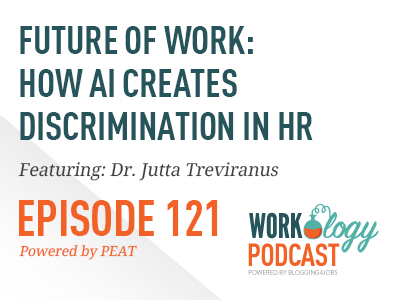Everywhere I turn there seem to be conversations in the human resources and recruiting industry centered around artificial intelligence. It is truly permeating our landscape. However, along with PEAT, I wondered if AI was as inclusive as it could be. We’re talking digging deep today, looking at the inclusiveness of machine learning technology and exploring the implications for people with disabilities.
Episode 121: Does Artificial Intelligence in HR & Recruiting Create Discrimination with Dr. Jutta Treviranus (@juttatrevira)
Dr. Jutta Treviranus is the director of the Inclusive Design Research Centre and a professor at OCAD University. Jutta has been working towards more inclusive and accessible technology for much of her life. Her focus is now on improving artificial intelligence systems so they can better serve everyone, including people with disabilities, and she organizes hackathons towards this goal.
We’re continuing our Future of Work podcast series in partnership with PEAT and taking a deeper dive into artificial intelligence and Dr. Treviranus’s research with a focus on HR and recruitment.
In the podcast interview, Dr. Treviranus provides listeners insights into what artificial intelligence is and how the pattern identification algorithms could, in fact, eliminate candidates or employees who don’t fit the ideal or common pattern. For example, these outliers to the pattern could be candidates with different backgrounds, experiences, or skill sets. All AI technologies not just those in HR and recruiting have a responsibility to be inclusive in order to not discriminate.
The Dimensions of Inclusiveness
Inclusion is important for everyone to recognize because it helps create systems of uniqueness. In order to do that, Dr. Treviranus says we need to do the following:
1) Ensure that there is an inclusive process
2) Allow everyone to participate in decisions and design
3) Incorporate co-design into your existing design process
Most importantly, she reminds us that no decision is made in isolation. It is all interconnected with or without artificial intelligence technology.
She goes on to say that we need an agile, diverse and creative team in our current work environment. We are no longer living or working in the industrial revolution. Technology is critical to our creativity, growth, development, and success.
How to Choose AI Technology That’s Inclusive
Since so many HR and recruiting leaders are considering adding AI to their workplace technology, Dr. Treviranus offered advice on choosing AI systems that are inclusive. The technology should have edge data and scenarios to improve their models and algorithms. She encourages buyers to be inquisitive and ask how the system is counteracting bias or if there is learning being done on the unexpected.
It’s also important for the machines to learn. Dr. Treviranus suggests that we ask for an AI system that allows for continuous improvement and a feedback loop to adjust the determination, the inferences and the model being used.
This year has truly been the year of artificial intelligence in HR and recruitment and my conversation with Dr. Treviranus provided me, and hopefully you, with a really eye-opening discussion. It’s important for HR leaders to understand how our artificial intelligence works and identifies patterns that might unknowingly eliminate candidates who don’t fit traditional patterns. If we are making purchase decisions, we need to push back on the AI developers to ensure it’s moving forward.
Connect with Dr. Jutta Treviranus on LinkedIn.
RECOMMENDED RESOURCES
-
- Inclusive Design Research Center Website ~ Dr. Jutta Treviranus’ Profile
How to Subscribe to the Workology Podcast
You can also click here to find out how to be a guest on the Workology Podcast.
*A special thank you to my production team at Total Picture Radio.









2 Comments
Hello Jessica, I think it is wrong to blame AI for discrimination. In fact, the technology is boosting the process of recruiting high-quality candidates and contributing to making the complex recruiting process not only simple but also easy. It helps recruiters to get deep insights of the candidates.
Phenomenal episode! Really brings forward the major questions around AI and diversity. As someone previously commented, AI could potentially help correct for some individual biases, but it all depends on how well the AI is built–and that depends on the data set and the algorithms, which are ultimately built, fed, and selected by humans with biases. Which really makes the case for AI tech that is transparent about how it is developed, and that is visible to people other than its designers, aka “white box.” I will now be looking for more information on this!
Comments are closed.